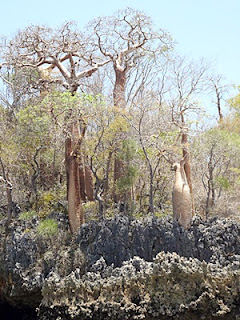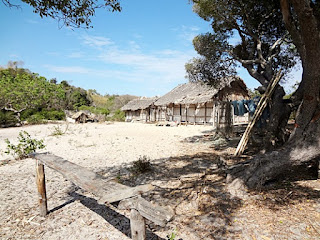We tacked up into this bay, across the shallow, narrow channel. We had to go in past the karst islands to find the other boats anchored back in the back bay. On the islands were lots of baobab trees. These giant trees, aka bottle trees or upside down trees because their branches look like a root system in the air were scattered on the islands. Here is Karen showing the size of one of the big ones on the beach.
These baobabs are growing right out of the rocks!
A canoe on the beach where we went for a walk.These baobabs remind me of the angry apple trees in The Wizard of Oz movie.
The cool squiggly marks in the bark were interesting on this tree.
They come in different colors and textures, too.
The karst/limestone islands seem to hang above the water at low tide, creating overhangs of sharp rock.
The islands look like mushrooms.
Lots of holes , arches, and crevices in the porous rock creates interesting designs up close.
A hole in the rock of one of the islands we passed coming in to anchor.
You could look right under the ledges of rock and see out the other side.
The water washes away the rock underneath until the island collapses.
This one looks ready to topple sometime soon.
This one has a cave that you can get into at high tide. It's supposedly a burial cave.
A skull of a zebu cow has been placed at the entry to the cave. We won't go in it. Rumor has it there may be human remains further into the cave, but we don't know anyone who went in to validate that rumor.
Up a small river tributary to see what is up there.
More baobabs on the beach.
Jason and the crew from Sage help a local carry his dugout canoe up above the high water line.
A spiny baobab growing right next to another kind of baobab tree. The light grey one has spines all over it.
A local left his knife hanging in the tree and his workstaion sitting on the sand. The shell on the right is a huge oyster. They have very thick shells here.
Some of the big shells laid around th ebase of a spiny baobab.
The flower blossom at the top of a spiny baobab.
Mangrove mud with roots growing up out of the ooze. They remind me of soldiers marching across a field.
The 'resort' on one of the islands around Moramba Bay. It had a pretty low roof. I like the twisted topknot of thatching on the roof.Inside the central room in the resort. Lots of VHS video tapes and a few books in different languages.
A big turtle shell in one corner of the room. They still eat turtle here once in a while. I've seen several shells recently taken from a turtle.
The resort has a solar oven!
This is Zaree. She and her son, Eddie, came to the beach in their canoe to take the fish out of their net. She had a bit of fruit and veges and told us she was from Village #3 and to come there if we wanted produce.
More big baobab trees. They are just so unusual.
Eddie, Zaree and their canoe. YOLO is anchored in the background.
We're off on a dinghy tour of the islands.
The river edge is rocks and trees and changes to mangroves.
It's usually pretty dry where you find baobab trees and this is no exception.
The tides go out a long ways on these shallow beaches. Those are dinghies in the background, with Tony and Jason walking up to catch up to the rest of us .
Inland a bit is where the lemurs were found in the trees ahead. The kids had scared them away the days before and they weren't here when we walked this far. It was so hot we decided not to search for them. They were probably resting somewhere in the shade like we should've been.
A smooth-barked baobab tree.
More gnarly tree growth, with lots of birds in this one.
A limestone island with exposed pillars of rock.
This green bird had sharp angles on it everywhere. It looked like a swallow, but we don't know what it really is.
More fanciful trees on the rocky islands.
The smoke from a big fire burned for days while we were here. Unfortunately, we see far too many forest fires burning on the mainland here. You could see the orange glow from the burn at night and the winds in the mornings and afternoons just whipped the fire up daily.
Village #2 had the most people in it and we took bagfuls of stuff to give away. Everyone here got something--a t-shirt, an empty bottle of container, needles, thread, soap, etc.
Even empty snack canisters were snatched up as treasures by these folks.
A beach from one of the villages.A baobab tree with lots of bird's nests in it.
A close up of a birds nest in a different tree.
This is Zaree and her family in Village #3. We took more stuff to them to give away and generally got some mangoes in return.
They quick-roast these little fish on the fire and then toss them on the roof to dry in the sun. Dried fish is a staple here. They were building a new canoe and a new bigger dhow in the village.
The bow of the dhow. Notice how thick the timbers are.
The inside of the dhow being built. They will make up some concoction to try to seal the seams, but they are never waterproof and the bucket will probably go to sea when this is launched to bail the boat.
Another view of the village. Very simple and very poor people here.
Jason with the kingfish we caught.
He tossed the carcass back out as bait but we reeled it back in shortly as we realized we wouldn't want whatever could eat that for bait!
We tucked into a small bay on the way further south and these guys were cleaning their fish at the water's edge. They put them in big bags and hauled them up the beach.
A big dugout canoe laid on its side up on the beach here. This beach had lots of shells and lots of smooth, rounded pebbles of quartz. Unusual and different from most beaches we'd seen here so far.
The red color doesn't really show up well when I zoom in from sailing over a mile off the shore, but the sculptured cliffsides were stunning along this stretch of shore.
A Spanish Mackerel we caught. We filled our freezer with fresh fish while sailing along this coast. Our friends on Saol Eile actually had one of these fish jump onto their boat one night! It was being chased by something big that bit its tail and made it jump ot of the water. It landed on their coachroof and they were quick enough to catch it before it flapped itself back into the water. Catching fish without even putting a hook or line in the water is a first for us to hear about! they'd caught so many fish that they shared the jumper around with the other boats in the anchorage at the time. Yummy.

Some of the bits of Spanish Mackerel that were left on the carcass after a quick fillet job ended up being marinaded and hung to dry for a nibbly snack. Bigger chunks would be called 'biltong' in South Africa, but I just made a few as Jason doesn't really like the stuff.































































No comments:
Post a Comment